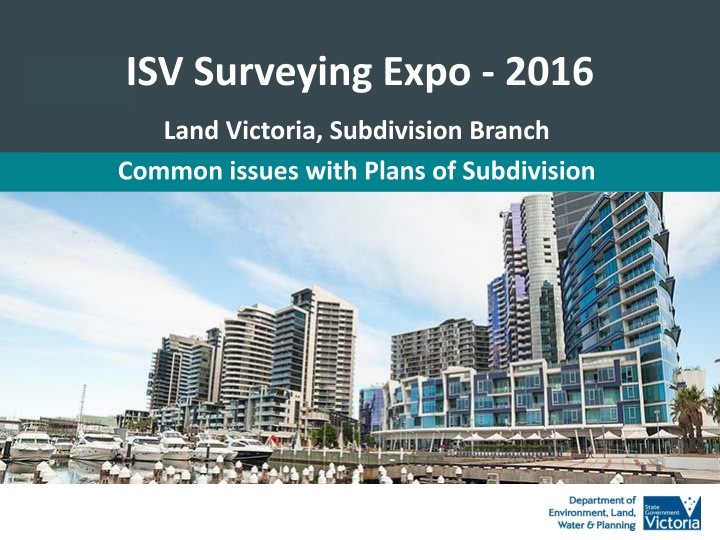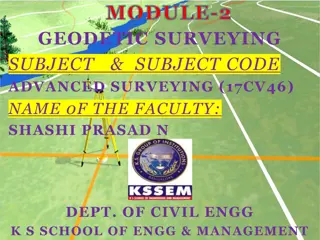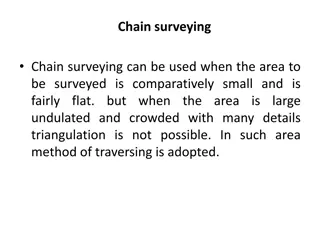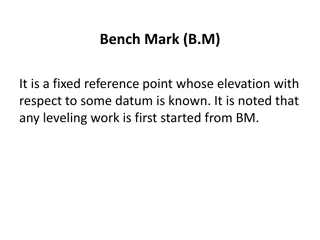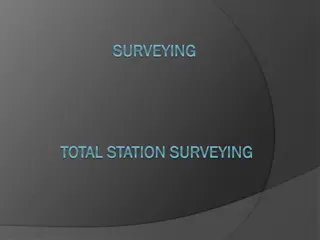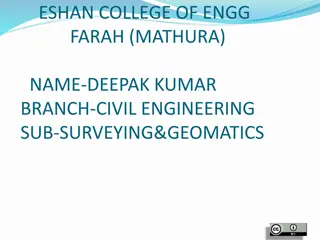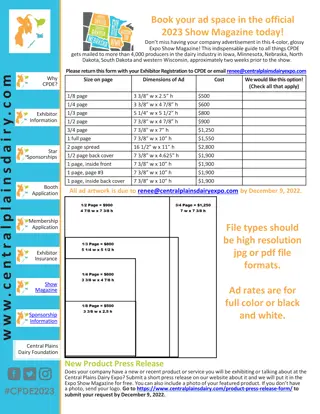Insights into ePlan Implementation and Collaboration in Surveying Expo 2016
In Surveying Expo 2016, discussions revolved around common issues with Plans of Subdivision, ePlan updates, Subdivision Branch status focusing on retirement of Neil Coupar, and ePlan implementation progress since May 2013. Additionally, a collaborative project with the University of Melbourne aimed at enhancing ePlan visualization tools for surveyors was highlighted. The content also delves into what can be included in an ePlan and an ePlan Engagement Program case study by SMEC comparing PDF vs. ePlan creation processes.
Download Presentation

Please find below an Image/Link to download the presentation.
The content on the website is provided AS IS for your information and personal use only. It may not be sold, licensed, or shared on other websites without obtaining consent from the author.If you encounter any issues during the download, it is possible that the publisher has removed the file from their server.
You are allowed to download the files provided on this website for personal or commercial use, subject to the condition that they are used lawfully. All files are the property of their respective owners.
The content on the website is provided AS IS for your information and personal use only. It may not be sold, licensed, or shared on other websites without obtaining consent from the author.
E N D
Presentation Transcript
ISV Surveying Expo - 2016 Land Victoria, Subdivision Branch Common issues with Plans of Subdivision
Introduction ePlan update Common issues with Plans of Subdivisions Questions Subdivision Branch status
Subdivision Branch Status Retirement of Neil Coupar Lodgements 2015/2016: 9103 plans (up 8%) Lodgement to Registration time - currently 15 days (available on SPEAR homepage) Next SPEAR release in October - introduces Lodging Parties as a new user Plans refused - 40% Plans requisitioned - 70%
ePlan Implementation Progress Since May 2013, ePlans have been able to be lodged in SPEAR instead of the PDF drafted by the surveyor ePlan supports Section 22 (Plan of Subdivision/Consolidation), 23, 24A, 26, 32, 32A, 32B, 35, 35(8), 37 (Stage Plan) and text-only plans SPEAR validates the ePlan data and creates a PDF LISCAD, GeoCivil, AutoCAD Civil 3D and 12D support ePlan in Victoria 60 ePlans submitted to SPEAR from 8 firms with 25 registered
Collaboration with the University of Melbourne Aim: design and develop an ePlan Visualisation Enhancement Tool to enable surveyors to: define sheets define exaggerations create enlargement diagrams adjust labels and arrows Further functions will be considered in the development of the tool through consultation with the surveying industry
What Can Be Included In An ePlan? Location (LGA) and Addresses Plan and Surveyor s Details Signatures & Approvals Lots Owners Corporation Details Roads Common Property Reserves ePlan LandXML File Field Notes Restrictions Survey Marks Easements Plan Occupation Observations Monuments Annotations
ePlan Engagement Program SMEC ePlan Case Study - PDF vs ePlan Creation Computed Plan Data Computed Plan Preparation Preparation for Stage 5 Input Copy Stage 5 Data to a New Drawing File Add Attributes to Computed Plan Duplicated drawing files Enriched Computed Plan as a single data source Draft the Plan of Subdivision in CAD Convert CAD file into ePlan Validate and Visualise ePlan Quality Assurance Amend Plan Amend Plan
Potential Benefits of ePlan Prepares a standard data exchange format for all stakeholders Upgrades the spatial accuracy of map base Pre-populates the Titling Provides pre-lodgement checks via Entire State System Validation Report Creates the OC reports and Eliminates the drafting step via new titles Visualisation Service Land Victoria Surveyors Reduces lodgement to Eliminates the duplication of drawing ePlan LandXML File registration turnaround time files by storing all required data in Provides the data for digital Computed Plan plan examination Speeds up the application creation process in SPEAR Councils and Referral Authorities Saves time in constructing the subsequent surveys Populates the Created Parcel Names for Street Addressing Auto-generates the Surveyor s Report Provides input for creating parcels databases (lots, roads, reserves, easements, restrictions)
Common Issues in Plans of Subdivision
Common Issues in Plans of Subdivision Plan requisitions are at 70% Goal of new Regulations in 2011 was to gain clarity in plans Summary of the most common issues that hold up plans Not counting patent errors and SPEAR format issues
Common Issues in Plans of Subdivision 1. General Plan Presentation 6. OC Setups (Multiples) 2. Easements 7. Section 32 Plans 3. Road Abuttals 8. Stage Plans 4. Building Subdivisions 9. Future Subdivisions 10.Re-establishment Issues 5. Cross Sections
1. General Plan Presentation Linework and Drafting Continuous lines only to be used for boundaries No boxouts or diagram borders Beware of arrows creating parcels by crossing boundaries Feature lines with large dash length on short lines need to be broken (>5mm) Thick lines are only for building boundaries! Fonts should be large, clear and standard Minimum 0.35 for dimensions, 0.5 for parcels, no smaller than 0.2 anywhere else
1. General Plan Presentation Plan Clutter Try not to cram everything onto single pages All boundaries must be clear and defined Use enlargements, split diagrams between sheets to avoid clutter Group cross sections together Restrictions are always on their own sheet!
2. Easements Confirm the easement purpose is valid and in keeping with the acceptable easement purpose document online Gas or Water or Access or Maintenance not enough information Look for easements not fixed, or not identified clearly Be clear about the land to be benefited
3. Road Abuttals If your plan shows a Road Abuttal that is not on title, it must be justified! Supply the letter from council or give gazette reference Give the justification in your Surveyor s report, don t just identify that it is not known
4. Building Subdivisions Building boundaries must be defined in two parts: Which lines? ie thick continuous lines , thick continuous hatched lines What is the boundary location? ie median, interior face, exterior face. Keep it simple and consistent Are there three separate boundary Locations ? Use three separately identifiable lines to define those locations!
4. Building Subdivisions Don t use different lines to represent the same boundary location ie Exterior face shown marked E and all other boundaries Do not only use ownership of a structure to define a boundary location Eg Boundaries are thick continuous lines and the walls are in Common Property No.1 Missing the Boundary Location!!!
4. Building Subdivisions A Common Property Exclusion statement is required if a single common property is not shown in plan view Eg Common Property No.1 is all the land in the plan except the Lots and Common Property No.2 . Used for CP airspace or overhanging lots Only valid for one Common Property. Any other CP Parcels must be fully defined as if they were Lots! Common Property Inclusion statements can be used to improve clarity where appropriate Eg Common Property No.1 is all the land in the plan except the Lots and Common Property No.2 and includes the structures of walls floors and ceilings except those marked M.
5. Cross Sections Once you have parcels above and below each other, make sure every parcel in the plan is defined in some way yes, even the unlimited ones Stating Typical is not enough. What is it typical for? You may need extra symbols where a section has multiple heights for part lots on that level Eg Lot 1(pt) is typical for those part lots marked #
6. Owners Corporation Setups Be aware of the Subdivision Act rules when creating multiple OC s Ensure ownership and use of common property is valid Unlimited OC owns CP Limited OC uses CP As soon as a lot is in a Limited OC with CP it must be in the Unlimited OC that owns the CP. Services are not linked to entitlement and liability. You don t need another OC with the same members!
7. Section 32 Plans Be sure to clearly define the Purpose of the Plan Each step must be set out in order, outlining exactly what the plan is doing Especially where subdividing with land not in the OC. The 32 must start with To bring the land into the OC
7. Section 32 Plans 32AI?? Do I need unanimous resolution? Section 32AI must be read as you need unanimous resolution unless you meet the criteria of 32AI 32AI is not a stand-alone section. Where section 32AI gives no option that is in 32 (eg create a road), it means 32AI does not apply
8. Stage Plans To subdivide a stage lot (ie S2), you must do a stage plan! This is due to certification and SOC for the balance lot If a new plan must be started, finish off the previous staging process using a text only 37(8) plan first (especially in the case of a section 32) or as a purpose of the new plan Have a compiled plan ready to go to speed up registration Remember to consider compatibility with earlier stages!
8. Stage Plans Be aware stage plans have additional rules regarding multiple Owners Corporations Creating a new Common Property in Stage 2? Then you need a new OC. Especially if no CP exists in the first stage
9. Future Subdivisions? When there is definitely going to be future development, think about options at the start If an OC is required in the first plan where there are balance S Lots and/or Super lots, make the OC Unlimited!! Limited OC = Limited options in the future!
Future Subdivisions A Big Problem All Lots in a Limited To Common Property OC As soon as CP No.2 is created anywhere: Unanimous Resolution !! S2 S3 ROAD ROAD ROAD R1 CP No.1 A STAGE 1 ROAD
10. Re-establishment issues Make sure there are at least three good marks from each survey Re-establish all abutting surveys! First in the island? Go around the block. Show radiations and/or chainage and offsets to occupation, and show ages! Make sure your report is comprehensive and complete, with the correct references!
Summary The common theme is: A Plan becomes a title diagram. Simplicity and clarity helps everyone understand the plan going forward!
Thank you! Questions?
